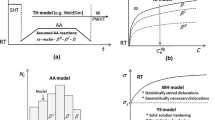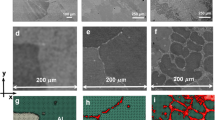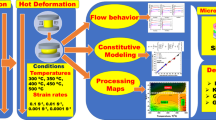Abstract
In this study, a combined precipitation, yield strength, and work hardening model for Al-Mg-Si alloys known as NaMo has been further developed to include the effects of strain rate and temperature on the resulting stress–strain behavior. The extension of the model is based on a comprehensive experimental database, where thermomechanical data for three different Al-Mg-Si alloys are available. In the tests, the temperature was varied between 20 °C and 350 °C with strain rates ranging from 10−6 to 750 s−1 using ordinary tension tests for low strain rates and a split-Hopkinson tension bar system for high strain rates, respectively. This large span in temperatures and strain rates covers a broad range of industrial relevant problems from creep to impact loading. Based on the experimental data, a procedure for calibrating the different physical parameters of the model has been developed, starting with the simplest case of a stable precipitate structure and small plastic strains, from which basic kinetic data for obstacle limited dislocation glide were extracted. For larger strains, when work hardening becomes significant, the dynamic recovery was linked to the Zener-Hollomon parameter, again using a stable precipitate structure as a basis for calibration. Finally, the complex situation of concurrent work hardening and dynamic evolution of the precipitate structure was analyzed using a stepwise numerical solution algorithm where parameters representing the instantaneous state of the structure were used to calculate the corresponding instantaneous yield strength and work hardening rate. The model was demonstrated to exhibit a high degree of predictive power as documented by a good agreement between predictions and measurements, and it is deemed well suited for simulations of thermomechanical processing of Al-Mg-Si alloys where plastic deformation is carried out at various strain rates and temperatures.













Similar content being viewed by others
Abbreviations
- b :
-
Magnitude of the Burgers vector (m)
- C i :
-
Concentration of specific element i in expression for σss (wt pct)
- C ss :
-
Equivalent solid solution concentration (wt pct)
- C r ss :
-
Value of Css for reference alloy (wt pct)
- c 1 :
-
Conversion factor for yield stress from 0K to room temperature
- \( \bar{F} \) :
-
Mean interaction force between particle and dislocation (N)
- f :
-
Particle volume fraction
- f o :
-
Volume fraction of non-shearable Orowan particles
- f r o :
-
Value fraction of fo in reference alloy
- k i :
-
Scaling factor in expression for σss (MPa/(wt pct)2/3)
- k 1 :
-
Parameter related to statistical storage of dislocations (m−1)
- k 1 g :
-
Parameter related to statistical storage of geometrically necessary dislocations (m−1)
- k 2 :
-
Parameter related to dynamic recovery of dislocations
- k 02 g :
-
Constant in expression for k2g
- k 2 g :
-
Parameter related to dynamic recovery of geometrically necessary dislocations
- k 02 :
-
Constant in expression for k2
- k *2 :
-
Constant in expression for dynamic recovery of dislocations
- k r2 :
-
Value of k2 in reference alloy
- k 3 :
-
Parameter determining the solute dependence of k2 (N/m2 wt pct3/4)
- l :
-
Mean planar particle spacing along the bending dislocation (m)
- M :
-
Taylor factor
- M r :
-
Taylor factor for reference alloy
- m :
-
Constant in expression for dynamic recovery of dislocations
- N i :
-
Number of particles per unit volume within the size class ri (#/m3)
- p :
-
Constant in expression for σ
- q :
-
Constant in expression for σ
- Q d :
-
Activation energy for diffusion (J/mol)
- R :
-
Universal gas constant (8.314 J/Kmol)
- r :
-
Particle radius (m)
- r i :
-
Particle radius within size class i (m)
- r c :
-
Critical particle radius for the transition from shearing to bypassing (m)
- t :
-
Time (seconds)
- T :
-
Temperature (K or °C)
- T m :
-
Melting temperature (K or °C)
- T r :
-
Room temperature (K or °C)
- Z :
-
Zener–Hollomon parameter (s−1)
- Z 0 :
-
Zener–Hollomon parameter at 0 K (s−1)
- Z r :
-
Zener–Hollomon parameter for reference alloy (s−1)
- Z s :
-
Constant in expression for k2 (s−1)
- Z g :
-
Constant in expression for k2g (s−1)
- α :
-
Constant in expression for σd
- ΔG :
-
Activation energy required to overcome obstacles without aid from external stresses (J/mol)
- ɛ :
-
Tensile strain
- \( \dot{\varepsilon } \) :
-
Tensile strain rate (s−1)
- \( \dot{\varepsilon }_{0} \) :
-
Reference strain rate in expression for σ (s−1)
- \( \dot{\varepsilon }_{r} \) :
-
Strain rate for reference alloy (s−1)
- ɛ p :
-
Plastic tensile strain
- θ g :
-
Material constant in expression for the temperature dependence of μ
- λ g :
-
Geometric slip distance (m)
- μ :
-
Shear modulus (N/m2)
- μ r :
-
Shear modulus for reference alloy (N/m2)
- μ 0 :
-
Shear modulus at 0 K (N/m2)
- ρ g :
-
Number density of geometrically necessary dislocations (m−2)
- ρ s :
-
Number density of the statistically stored dislocations (m−2)
- σ :
-
Flow stress (N/m2)
- \( \hat{\sigma } \) :
-
Yield stress at 0 K (N/m2)
- σ d :
-
Net contribution from dislocation hardening to flow stress (N/m2)
- σ i :
-
Intrinsic yield strength of pure aluminum (N/m2)
- σ p :
-
Contribution from hardening precipitates to the overall macroscopic yield strength (N/m2)
- σ p1 :
-
Contribution from clusters to the overall macroscopic yield strength (N/m2)
- σ p2 :
-
Contribution from hardening β″ and β′ to the overall macroscopic yield strength (N/m2)
- σ ss :
-
Contribution from alloying elements in solid solution to the overall macroscopic yield strength (N/m2)
- σ y :
-
Overall macroscopic yield strength at room temperature (N/m2)
References
G. Edwards, K. Stiller, G. Dunlop, and M. Couper: Acta Mater., 1998, vol. 46, pp. 3893-04.
M. Murayama, K. Hono, M. Saga, and M. Kikuchi: Mater. Sci. Eng. A, 1998, vol. 250, pp. 127-32.
I. Dutta, and S.M. Allen: J. Mater. Sci. Lett., 1991, vol. 10, pp. 323-26.
W.F. Miao and D.E. Laughlin: Scripta Mater., 1999, vol. 40, pp. 873-78.
C.D. Marioara, S.J. Andersen, J. Jansen, and H.W. Zandbergen: Acta Mater., 2001, vol. 49, pp. 321–28.
J.S. Langer and A.J. Schwartz: Physical Review A, The American Physical Society, 1980, vol. 21, pp. 948-958.
R. Kampmann, H. Eckerlebe, and R. Wagner: Mat. Res. Soc. Symp. Proc., MRS, 1987, vol. 57, pp. 525–42.
R. Wagner and R. Kampmann: Material Science and Technology—A Comprehensive Treatment, vol. 5, VCH, 1991, pp. 213–303.
A. Bahrami, A. Miroux, and J. Sietsma: Metall. Mater. Trans. A, 2012, vol. 43A, pp. 4445-53.
D. Bardel, M. Perez, D. Nelias, A. Deschamps, C. R. Hutchinson, D. Maisonnette, T. Chaise, J. Gamier, and F. Bourlier: Acta Mater., 2014, vol. 62, pp. 129-140.
Q. Du, B. Holmedal, J. Friis, and C. Marioara: Metall. Mater. Trans. A, 2016, vol. 47A, pp. 589-599.
Q. Du, K. Tang, C.D. Marioara, S.J. Andersen, B. Holmedal, and R. Holmestad: Acta Mater., 2017, vol. 122, pp. 178-186.
M. Perez, M. Dumont, and D. Acevedo-Reyes: Acta Mater., 2008, vol. 56, pp. 2119-32.
Q. Du, Y. Li: Acta Mater. 2014, vol. 71, pp. 380-389.
P. Maugis, M. Goune: Acta Mater. 2005, vol. 53, pp. 3359-67.
Q. Du, W.J. Poole, M.A. Wells: Acta Mater., 2012, vol. 60, pp. 3830-39.
Q. Chen, J. Jeppsson, J. Ågren: Acta Mater., 2008, vol. 56, pp. 1890-96.
E. Kozeschnik, I. Holzer, B. Sonderegger: J. Phase Equilibria Diffusion, 2007, vol. 28, pp. 64-71.
A. Deschamps and Y. Bréchet: Acta Mater. 1999, vol. 47, pp. 293-305.
O.R. Myhr, Ø. Grong, and S.J. Andersen: Acta Mater., 2001, vol. 49, pp. 65-75.
L.M Cheng, W.J. Poole, J.D. Embury, and D.J. Lloyd: Metall. Mater. Trans. A, 2003, vol. 34A, pp. 2473-81.
W.J. Poole and D.J. Lloyd: Proc. 9th Int. Conf. on Aluminium Alloys, Institute of Materials Engineering Australasia Ltd, 2004, pp. 939–44.
U.F. Kocks: J. Eng. Mater. Technol., 1976, vol. 98, pp. 76-85.
H. Mecking and U.F. Kocks: Acta Metall., 1981, vol. 29, pp. 1865-75.
Y. Estrin: in Unified Constitutive Laws of Plastic Deformation, A.S. Krausz and K. Krausz, eds., Academic Press, New York, NY, 1996, pp. 69–106.
Y. Estrin: J. of Mater. Proc. Technol., 1998, vols. 80-81, pp. 33-39.
H. J. Frost, and M. F. Ashby: Deformation-Mechanism Maps. The Plasticity and Creep of Metals and Ceramics, Oxford (England), Pergamon Press, 1982.
A.G. Evans and R.D. Rawlings: Phys. Stat. Sol., 1969, vol. 34, pp. 9-31.
Y. Bergström, H. Hallén: Mater. Sci. Eng., 1982, vol. 55, pp. 49-61.
A.H. van den Boogaard and J. Huétink: Comput. Methods Appl. Mech. Engrg., 2006, vol. 195, pp. 6691-6709.
O.R. Myhr, Ø. Grong and C. Schäfer: Metall. Mater. Trans A, 2015, vol. 46A, pp. 6018-39.
O.R. Myhr, Ø. Grong, and K.O. Pedersen: Metall. Mater. Trans. A, 2010, vol. 41A, pp. 2276-89.
O.R. Myhr, and Ø. Grong: Acta Mater., 2000, vol. 48, pp. 1605-15.
O.R. Myhr and Ø. Grong: ASM Handbook, Welding Fundamentals and Processes, ASM, vol. 6A, 2011, pp. 797–18.
O.R. Myhr, Ø. Grong, H.G. Fjær and C.D. Marioara: Acta Mater., 2004, vol. 52, pp. 4997-08.
J.K. Holmen, T. Børvik, O.R. Myhr, H.G. Fjær, O.S. Hopperstad: International Journal of Impact Engineering, 2015, vol. 84, pp. 96-107.
J. Johnsen, J.K. Holmen, O.R. Myhr, O.S. Hopperstad, T. Børvik: Comp. Mat. S., 2013, vol. 79, pp. 724-735.
C. Dørum, O.G. Lademo, O.R. Myhr, T. Berstad, O.S. Hopperstad: Computers & Structures, 2010, vol. 88, pp. 519–528.
A.J.E. Foreman and M.J. Makin: Phil. Mag., 1966, vol. 14, pp. 911-924.
L.M. Brown and R.K. Ham: in Strengthening Methods in Crystals. A. Kelly and R.B. Nicholson, eds., Applied Science Publishers Ltd., Academic Press, London, 1971, pp. 9–135.
A.J. Ardell: Metall. Mater. Trans. A, 1985, vol. 61A, pp. 2131-65.
U.F. Kocks: Phil.Mag., 1966, vol. 13, pp. 541-66.
A. Rusinek, J.A. Rodríguez-Martínez: Materials & Design, 2009, vol. 30, pp. 4377-90.
K. Teichmann, C.D. Marioara, S.J. Andersen, and K. Martinsen: Metall. Mater. Trans. A, 2012, vol. 43A, pp. 4006-14.
K. Teichmann, C.D. Marioara, S.J. Andersen, and K. Martinsen: Materials Characterization, 2013, vol. 75, pp. 1-7.
F. Fazeli, C.W. Sinclair, and T. Bastow: Metall. Mater. Trans. A, 2008, vol. 39A, pp. 2297-2305.
M. F. Ashby (1970) Phil. Mag. J., vol. 21, pp. 399-424.
S. Gouttebroze, A. Mo, Ø. Grong, K.O. Pederesen and H.G. Fjær: Metall. Mater. Trans. A, 2008, vol. 39A, pp. 522-534.
V. Vilamosa, A.H. Clausen, T. Børvik, S.R. Skjervold, O.S. Hopperstad: Int. Journal of Impact Engineering, 2015, vol. 86, pp. 223-239.
U.F. Kocks, A.S. Argon, and M.F. Ashby: Thermodynamics and Kinetics of Slip, Progress in Materials Science, vol.19, Pergamon, Oxford (England), 1975.
V. Vilamosa, A.H. Clausen, T. Børvik, B. Holmedal, O.S. Hopperstad: Materials & Design, 2016, vol. 103, pp. 391-405.
V. Vilamosa, A.H. Clausen, E. Fagerholt, O.S. Hopperstad and T. Børvik: Strain, 2014, vol. 50, pp. 223-235.
V. Vilamosa: Doctoral Thesis, Norwegian University of Science and Technology, Department of Structural Engineering, Trondheim, 2015.
H.G. Fjær, B.I. Bjørneklett, and O.R. Myhr: Proc. TMS Annual Meeting, San Francisco, CA, Feb. 2005, TMS, Warrendale, PA, 2005, pp. 95–100.
Acknowledgments
The authors gratefully appreciate the financial support from NTNU and the Research Council of Norway through the FRINATEK Program, Project No. 250553 (FractAl), and the Centre for Advanced Structural Analysis, Project No. 237885 (CASA).
Author information
Authors and Affiliations
Corresponding author
Additional information
Manuscript submitted December 3, 2017.
Rights and permissions
About this article
Cite this article
Myhr, O.R., Hopperstad, O.S. & Børvik, T. A Combined Precipitation, Yield Stress, and Work Hardening Model for Al-Mg-Si Alloys Incorporating the Effects of Strain Rate and Temperature. Metall Mater Trans A 49, 3592–3609 (2018). https://doi.org/10.1007/s11661-018-4675-3
Received:
Published:
Issue Date:
DOI: https://doi.org/10.1007/s11661-018-4675-3




